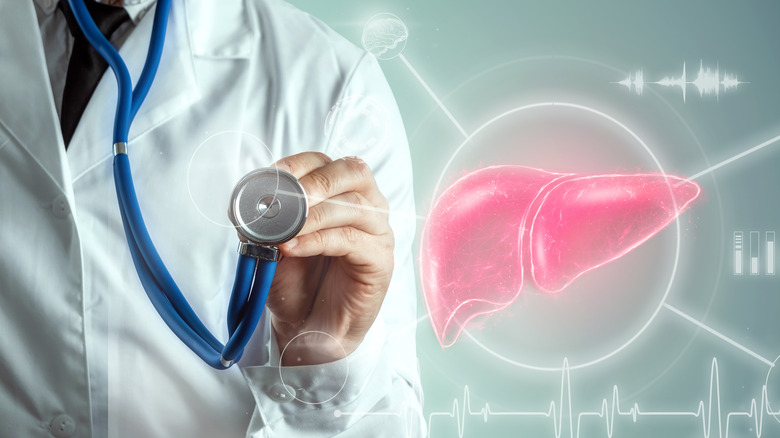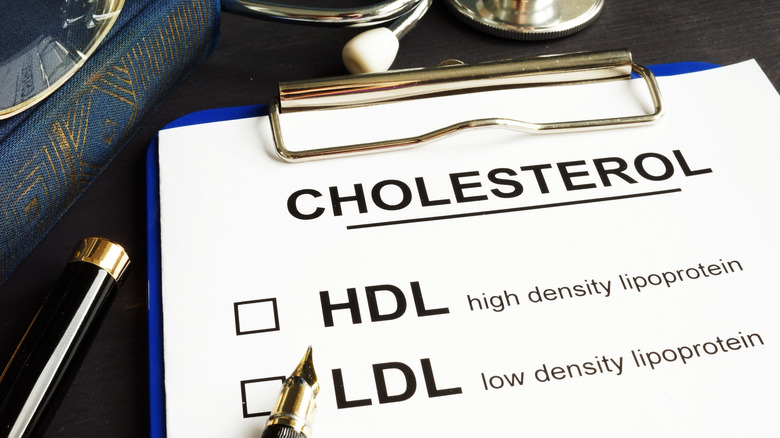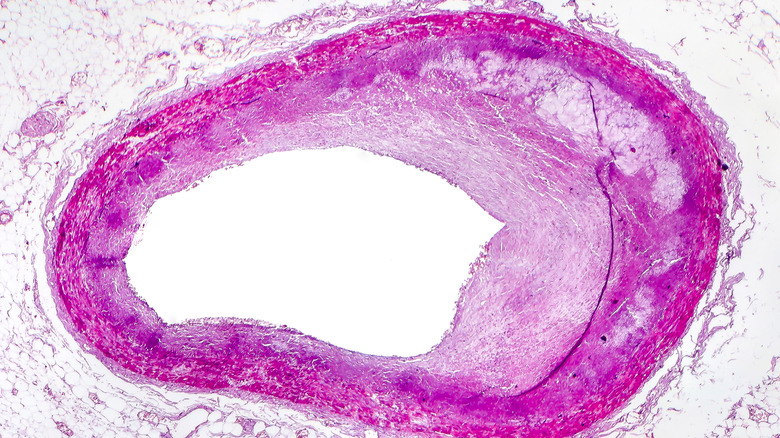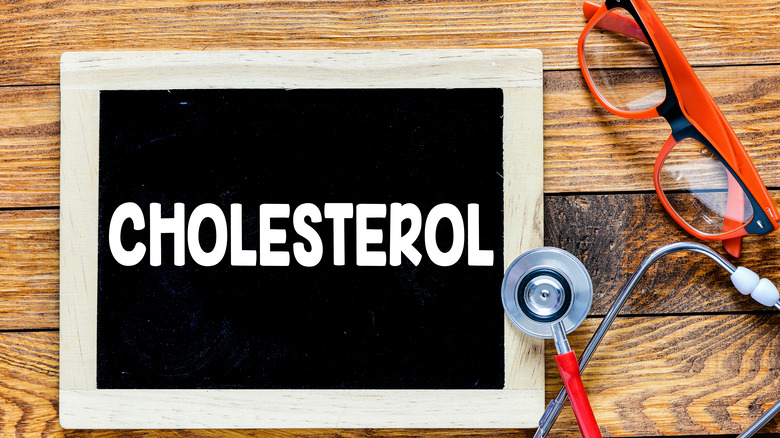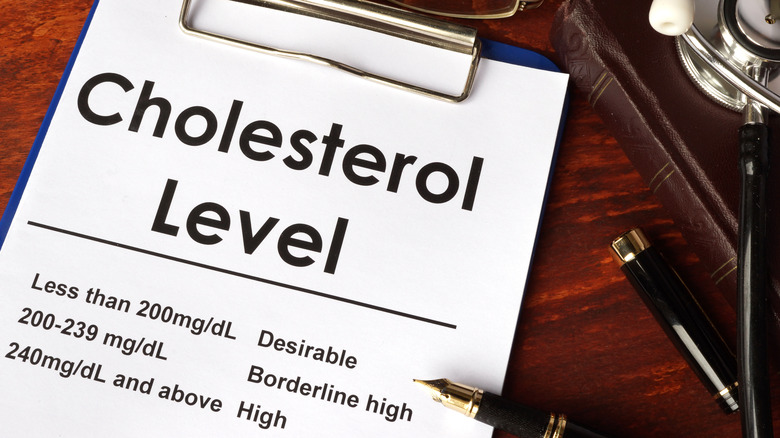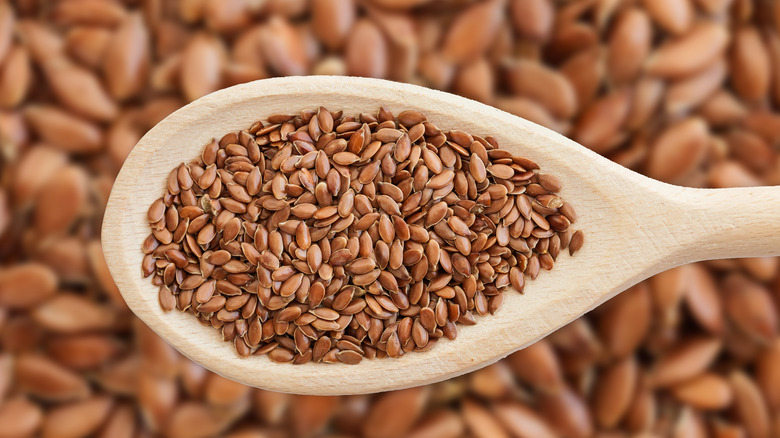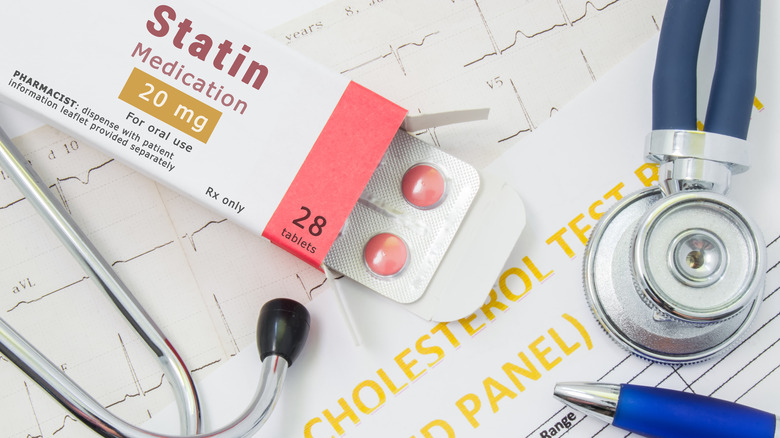High Cholesterol Explained: Causes, Symptoms, And Treatments
"I have to watch my cholesterol." How many times have we heard someone say this, but not really understood what it means? We might have been told that high cholesterol is bad for us, but what harmful effects does it actually cause in the body — and how can we prevent our cholesterol from getting too high?
To understand high cholesterol, it's important to take a look at the way your body processes and uses fat. You might be surprised to learn that your body actually does need some cholesterol, and that there's such a thing as good cholesterol and bad cholesterol (via the American Academy of Family Physicians). It's only when your body goes out of balance that you have a problem. As with other health conditions, high cholesterol is best avoided by preventative methods rather than treated after it's already become a problem.
Here's everything you need to know if you're going to fully understand high cholesterol as a health condition.
Your body produces cholesterol on its own
When most people think of cholesterol, they usually think of something harmful for their body. After all, whenever you hear about cholesterol it's usually in the context of it being too high — and that those with high cholesterol need to lower it. But what few people might realize is that, in the right amount, cholesterol isn't harmful to you. In fact, your body needs some amount of cholesterol if it's going to create cells or release hormones (via American Heart Association). But you don't actually need to consume cholesterol from dietary sources, because your liver is able to produce a sufficient amount for your body's needs.
When you consume too much dietary cholesterol from animal sources like meat, butter, and dairy, you put yourself at risk of accumulating too much cholesterol in your bloodstream. This risk can be compounded further when the food source is also high in saturated and trans fats, which prompt your liver to up its own cholesterol production. In turn, high levels of cholesterol can set you up for a variety of health problems.
There's HDL and LDL cholesterol
When you hear health experts talk about cholesterol, they'll usually refer to "good cholesterol" and "bad cholesterol." But there are formal names for these two types of cholesterol. The "good" kind is officially known as high-density lipoproteins, or HDL for short, and the "bad" kind is low-density lipoprotein, or LDL (via the Mayo Clinic). Both serve specific functions within your body.
LDL is responsible for delivering cholesterol particles through your blood to all parts of your body, whereas HDL is responsible for removing excess LDL from your bloodstream and returning it to the liver. Your fat intake affects your body's balance of LDL and HDL. Saturated fats will raise your blood cholesterol whereas monounsaturated fat and polyunsaturated fat will lower your LDL cholesterol levels (via MedlinePlus).
It's important to avoid letting your LDL levels get much higher than your HDL. When your body has more LDL than HDL, it's difficult for HDL to keep up with the LDL, and cholesterol starts to accumulate in your bloodstream.
Cholesterol builds up on the walls of your arteries
When you have high cholesterol — that is, that your body has more cholesterol than it can use — the excess cholesterol enters the bloodstream and actually builds up along the walls of your arteries (via the American Academy of Family Physicians). Because cholesterol is naturally a waxy substance, you might picture this like a pipe that has residue or deposits stuck to its inner lining. And as with your household plumbing, this isn't something you want to happen inside your body.
When your arteries are full of plaque (the clinical term for a buildup of cholesterol), there's a much narrower pathway for your blood to make its way through. This can lead to a variety of problems such as angina, the clinical term for chest pain. This is the most significant symptom of coronary artery disease, which develops when blood flow to your heart is restricted. In an especially bad scenario, a piece of plaque could break off and form a clot that could block an artery entirely.
Complications include heart attack and stroke
When plaque breaks off and forms a blood clot, or the plaque buildup on the arterial walls becomes so severe that the pathway is blocked entirely, it can lead to a variety of dangerous health conditions including a heart attack or a stroke (via the Mayo Clinic). In the case of a heart attack, blood cannot make it through an artery to reach the heart. This causes your heart to stop pumping. Similarly, if blood flow to the brain is blocked, you suffer what's known as a stroke. Both of these complications can be instantly fatal or could cause long-term damage. Signs of a heart attack include tightness in the chest, indigestion, fatigue, dizziness, lightheadedness, or a cold sweat, according to the Mayo Clinic. In the case of a stroke, you might have troubling speaking or walking, paralysis or numbness, or even vision problems and headaches (via the Mayo Clinic).
Risk factors for high cholesterol
The health risks associated with high cholesterol sound scary, and what's more troubling is the relationship between high cholesterol and other health problems. For example, high cholesterol is often association with health conditions like type 2 diabetes and obesity, according to the Centers for Disease Control and Prevention. That's because type 2 diabetes can lower your HDL levels and raise your LDL levels. Additionally, obesity can lead to high triglycerides.
The CDC also lists lifestyle behaviors that might be negatively affecting your cholesterol levels. Because of the way saturated fat and trans fat affect your balance of HDL and LDL, a diet that's high in these two nutrients can put you at risk. Additionally, a sedentary lifestyle without enough exercise leads to weight gain, which is often linked with raised cholesterol levels. Finally, there's smoking cigarettes. While smoking is often associated with poor lung health, it's important to remember that this bad habit also affects your blood vessels. A smoker's blood vessels are prone to collecting deposits of cholesterol. Additionally, smoking exacerbates any HDL-LDL imbalance by lowering your HDL levels.
There are no symptoms of high cholesterol
Although there are signs to look out for that a heart attack or stroke is imminent, there are no recognizable symptoms of high cholesterol. That means you might not know your cholesterol is too high until it's too late. That's why it's important to be proactive — and the only way to know your cholesterol levels is a test known as a lipid panel (via FH Foundation). A desirable blood cholesterol level is less than 200 milligrams per deciliter of blood. If your cholesterol levels are in the range of 200-239 mg/dL, they would be considered close to high-risk. Once your blood cholesterol levels exceed 240 mg/dL, your risk of associated health problems like heart attack or stroke is considered high.
It's important to also look at your LDL and HDL levels. LDL levels should be less than 100 mg/dL of blood, but people with heart disease should ideally have LDL levels lower than 70 mg/dL. If your LDL levels exceed 190 mg/dL, then you're at high risk. Men should make sure their HDL levels are 40 mg/dL or higher, and women should make sure theirs are at 50 mg/dL or higher.
How often should your cholesterol levels be tested?
Don't assume that getting tested to know your cholesterol levels is something you should only do if you're middle-aged. Even children should be tested for high cholesterol — and you should get tested regularly throughout your lifetime.
How regularly? The Mayo Clinic notes that the National Heart, Lung, and Blood Institute recommends children be tested for the first time when they are 9 to 11 years old. Testing for high cholesterol should then be done once every five years into adulthood. When men reach the age of 45 and women reach the age of 55, cholesterol tests should be done at least once every two years. After you reach age 65, you should have your cholesterol tested every year to make sure your levels are within a healthy range.
These time frames, however, are assuming that your cholesterol levels are where they should be or that you don't have risk factors like diabetes or heart disease. In cases of high cholesterol or additional risk factors, a doctor will likely recommend that you get tested more often.
High cholesterol could be genetic
Unfortunately, your cholesterol levels might not be entirely within your control. People with otherwise good health could be at risk of developing high cholesterol because of a genetic condition called familial hypercholesterolemia (FH), as noted by the FH Foundation. This condition affects one in every 250 people, but unfortunately, 90% of those with it are undiagnosed.
In the case of FH, a person is prone to high cholesterol because a genetic mutation affects the way LDL is moved out of their bloodstream. This leads to higher levels of LDL and, in turn, excess cholesterol buildup on artery walls. Because FH, like high cholesterol caused by lifestyle factors, has no symptoms, it's not always easy to detect. There's also very little public awareness of FH, so some people might not even think to test for it. But because it's passed down genetically — and parents have a 50% chance of passing it along to their child — it's important that the family of anyone with FH be tested for early detection.
Small lifestyle changes can make a big difference
Whether you're somebody who has high cholesterol because of genetics or because of your lifestyle, adopting heart-healthy practices can help you keep your levels in check. What kinds of healthy habits are best? Think of the commonsense guidelines that doctors and health experts have been promoting all your life — eat well, get exercise, and avoid smoking.
Specifically, the Mayo Clinics advises that, when it comes to your diet, avoiding saturated fat and trans fat — both of which can raise your LDL levels — is important. However, there are some kinds of fats that are good for you, such as omega-3s found in fatty fish. About 30 minutes of moderate activity fives times a week is sufficient exercise to help you achieve the benefits for your heart. If you're short on time, you can boost your workout to a vigorous intensity and dedicate only 20 minutes three times a week to exercise. Finally, giving up smoking can offer improvements such as improved blood flow, better lung function, and reduced risk of heart disease, all within three months to a year.
Foods to avoid to lower your cholesterol
It's kind of difficult to navigate which foods are helpful and which are harmful when it comes to improving your high cholesterol levels. For example — eggs. You've probably heard they have a lot of cholesterol, so you want to avoid them, right? Not necessarily, according to the Cleveland Clinic. One egg has 60% of the amount of cholesterol you should eat in a day, but they have plenty of beneficial nutrients like protein and iron. In the big picture, they aren't that bad.
Instead, the foods you should be concerned about are those with a lot of saturated fat (which eggs have in much lower amounts). Full-fat dairy, including not only milk but also yogurt, cheese, ice cream, and butter, is high in saturated fat, which raises your blood cholesterol. Swap out any dairy products made from whole milk and seek those made from fat-free, low-fat, or reduced-fat milk instead. Red meat, such as beef and pork, and processed meat, such as hot dogs, are other major sources of saturated fat. When possible, go for lean cuts or opt for poultry.
Fiber is helpful in lowering your cholesterol
What if you could remove cholesterol from your body before it even gets absorbed from your digestive tract — that way, it never even gets in your bloodstream and your body is able to balance itself out naturally, right? Well, here's something good to think about: soluble fiber does just that (via Harvard Health Publishing). Soluble fiber is a type of fiber that binds to cholesterol while it's in your digestive tract. Then it carries the cholesterol out of your body with it. That's why you might have seen nutritional guidelines that say you should have 5-10 grams of soluble fiber (at a minimum) every day.
If you're not getting enough fiber, you're not alone — most Americans get only half the amount of fiber they should be getting. You can get more soluble fiber in your diet by eating oats (either in the form of oatmeal or some kind of oat-based cereal), beans, nuts, apples, and other fruits and vegetables.
The Mediterranean diet is a great option for keeping cholesterol in check
There's no need to think that a heart-healthy diet is going to be a boring or unsatisfying one. Even if you love butter, hamburgers, bacon, and cheese, that doesn't mean there aren't options out there that can impress your palate — maybe even to a greater degree. Johns Hopkins Medicine recommends the Mediterranean diet because it's delicious and satisfying while still improving heart health because of its low saturated fat content and high unsaturated fat content. In fact, Johns Hopkins spent eight years tracking a group of more than 6,000 test subjects who ate Mediterranean for eight years and saw their risk of heart disease and plaque buildup shrink by 80%.
The Mediterranean diet emphasizes foods like fish, vegetable oils, whole grains, nuts, beans, low-fat dairy products, and plenty of fresh fruits and vegetables. Many foods you already stock in your kitchen might be considered part of the Mediterranean diet, including hummus, olive oil, brown rice, lentils, and avocados.
Dietary supplements like red yeast rice, flaxseed, and garlic could help
Here's something interesting to consider: Although there's not enough scientific research to be conclusive at this point, some supplements might provide you the nutritional boost you need to bring your high cholesterol levels down according to the National Center for Complementary and Integrative Health (NCCIH). Three supplements to consider: red yeast rice, flaxseed, and garlic. Researchers have their eyes on these supplements for varying reasons. For example, red yeast rice has monacolin, a substance that imitates the effects of lovastatin, a type of drug that lowers cholesterol. Flaxseed and garlic are two foods that can commonly be found in supplement form touted for their heart-healthy benefits.
While this sounds promising, it's important to remember that none of these supplements is supported by conclusive research, so it's best to use these methods to complement a healthy lifestyle, not to take the place of one. It's also important to talk to your doctor about any potential side effects — garlic, for instance, has the potential to interfere with the HIV drug saquinavir, the NCCIH explains.
Medications can help keep cholesterol levels in check
The unfortunate reality is that sometimes a healthy lifestyle just isn't enough to manage or lower high cholesterol. If you're somebody with FH, or you're a person whose cholesterol levels are especially high, your doctor might recommend using medication in addition to beneficial lifestyle choices.
The Beth Israel Lahey Health Winchester Hospital notes that a popular type of cholesterol medication is a statin, which blocks HMG-CoA reductase — the enzyme in your liver that creates cholesterol — from doing its thing. Brand names for statins include Atorvastatin, Fluvastatin, and Lovastatin, among others. Other types of cholesterol medications include resins, cholesterol absorption inhibitors, and fibrates (via American Academy of Family Physicians). Some patients take more than one type of cholesterol-lowering medication.
It's important to remember that medications aren't the full solution to the problem — in other words, taking cholesterol-lowering drugs aren't a green light to eat all the cheeseburgers you want. Reaching and maintaining ideal cholesterol levels continues to be about a diet low in saturated fat and high in fiber, plus getting plenty of physical activity.


